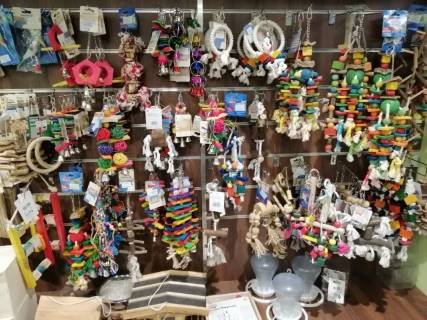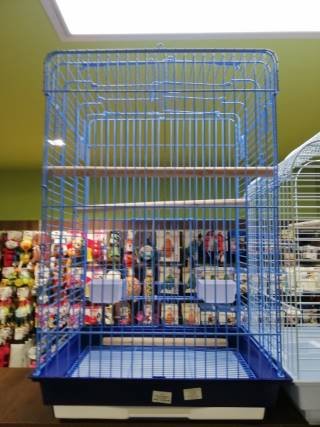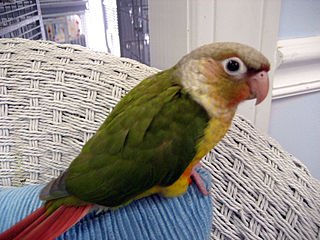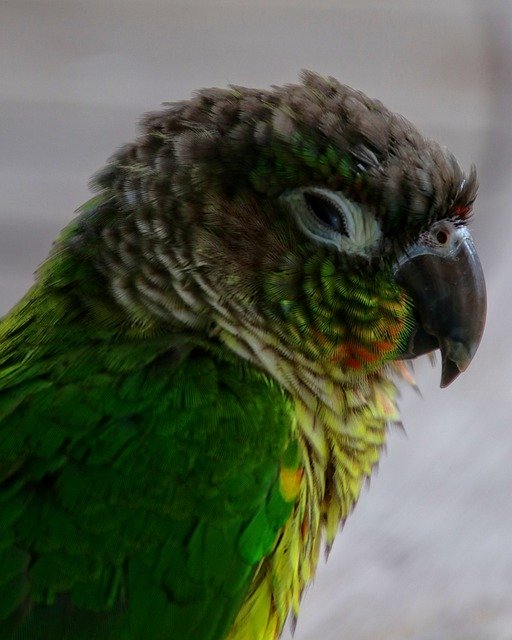One of the favorite conures, the green cheek conure, owes his popularity to his playful and fun-loving nature. Always full of energy,, a green cheek demands an equally energetic living space. A cage that oozes comfort and liveliness is what is meant to be the ideal home for any green cheek. Let’s get to all the minute cage details deemed perfect for a green cheek.
Best Cage Shape for a Green Cheek Conure
For a green cheek conure, the best cage shape would be the one with angles, i.e. square or rectangular. Round cages are a big no for the little bird. This is because:
- Angular cages make the bird assured about their locations in a territory getting marked. Whereas in round cages, they do not have any reference point to mark their zones which makes them feel like they are just getting nowhere around. This makes the bird feel less secure about his home.
- Round cages are often small or just enough for a single bird to inhabit. Green cheeks end up brushing their tail feathers along the cage bars almost every time they move around the cage. The rubbing has been reported to cause permanent damage to their feathers. This possibly is enough reason to avoid a rounder cage.
- Apart from lending a ragged appearance to the green cheek, the round cage also imparts loneliness to the little bird as the probability of having two birds in a round cage is almost nil. The only chance of procuring a big cage for a green cheek pair is to get it made on-order. Or be ready to shoulder the responsibility of an aggressively fighting green cheek pair, especially during the breeding season.
- Round cages are a storehouse of bacteria, especially at places like the top knot where all the bars gather. All the dust and grime tend to collect at such places and it is difficult to even wipe them with a wet cloth. Another reason for these cages to be messy is that their top area needs to be popped off the bottom grate even just to clean the bottom. This is no fuss-free cleaning.
- Lastly, round cages aren’t meant to fit in all the accessories and toys of the little green cheek. Today all cages are either square or rectangular and the accessories are thus, designed to fit them only. It is almost impossible to perches, feeders, and toys that can successfully fit a round cage also. And accessories are undoubtedly a must-have in a green cheek’s life. So going for an angular cage is best for the physical as well as the mental health of a green cheek conure.
Best Cage Material for a Green Cheek Conure
The best material for a green cheek cage is stainless steel. There are many reasons to go for a stainless steel construction over the others:
They are sturdier than the rest of the cage materials available in the market. It is not a child’s play to topple them. Hence, the little bird is always safely secured to his place, quite literally.
Another reason for choosing stainless steel is that they don’t rust like other metal cages. Thus, the bird is never at risk of catching metal poisoning. Though the acrylic cages also qualify here, they are deemed as less sturdy.
Lastly and most importantly, it is easier to clean stainless steel cages without causing them to scratch unlike most of the other materials. Just a wet wipe every weekend and the cage is like new once again. There is no rust-grime like an iron or zinc cage. Neither is there a stubborn dirt layer stuck at the base ready to leave scratches behind like an acrylic cage.
Apt Cage Size for a Green Cheek Conure
After having zeroed in the best cage shape and material, it’s time to finalize the perfect size for the pet green cheek conure. Though a medium-sized conure, a green cheek conure is no less than a large parrot, in context to his personality.
To house a single Green Cheek Conure
A green cheek needs a large cage encompassing enough for all his necessities and comforts. So, if the need is to house a single bird, it is best to have a cage that is at least 18 inches in length, breadth, and height. This size is apt to add all the accessories to the cage apart from allowing plenty of space for the bird to fly and roam about.
To house a Green Cheek Conure pair
If the intention is to house a green cheek pair or for that matter, a same-sex companion bird, it is best to go for a little larger cage. The minimum cage dimensions to establish a pair should be 24 inches in length, breadth, and height. If the price is not premium, it would be best to have a cage measuring 30 inches in all dimensions.
Necessary Cage Accessories for a Green Cheek Conure
Once the cage has been procured, the next consideration to make while setting up the cage is to make it worth living. The green cheek must not only have all the necessities at his disposal inside but the comforts too, for convenience. Let’s go through all the accessories that are must-haves for the little bird to let him dwell happily inside:
Feeders
Feeders fall in the basic needs while categorizing cage accessories. They are generally best clipped to the bars of the cage against placing them on cage floors. This is the best way to keep the cage devoid of all the probable mess. There are varying options, both offline and online when it comes to the material, shape, and size of the feeders. Choose the best one that fits the cage and serves the purpose well.
Though the number of feeders is completely subjective, most of the cages have around four of them: for seed-mix, for chopped fruits and vegetables, for freshwater, and one for pellets. Many owners prefer to feed pellets in the same bowl as seed-mix and keep the fourth bowl as a backup for freshwater supply, for the bird’s convenience in hotter times.
Perches
It goes even without saying that perches are even a part of a green cheek conure in the wild. Hence, they need at least a few of them, even indoor; to feel as close as possible to his natural habitat, and also, to flex all his feet muscles well. Grinding of beak and nails are yet another bonus.
But what needs deliberation is the number of perches and their sizes. If the cage size is around 18 inches, it is best to install around 4-5 of them. But not all of them must be equal in length and width. Choose some of half an inch and others of three-fourth of an inch. This would facilitate healthy muscle movements and teach the bird to firm his grip.

Also, not all perches must be equal in length. Keep some shorter and the others a bit longer. Also, place them at varying heights to let the bird learn to fly at higher as well as at lower altitudes. Ensuring all this eventually keeps the bird fit in the longer run.
Lastly, it is imperative to choose perches that are made from organic wood to prevent the bird from hurting and facilitating beak and nail grinding, like in the wild. It is best to avoid the more-famous aluminum perches that are deemed trendy by many pet owners.
Toys
Here comes the fun part of the cage setup: the toys. All the green cheek parents are aware of the importance of toys in their bird’s life. So, the time is to add a few good ones to stimulate the bird, both physically and mentally:

Toys for mental stimulation
To keep the green cheek mentally fit and stimulated, add as much toys like:
Foraging Toys: These are the ones that make the little bird put his detective skills at work. The most famous ones are with hidden treats for the green cheek inside. The bird uses his intelligence to unwrap and unearth the hidden treat inside.
Puzzle Toys: These toys are meant to brush up the intelligence level of the green cheek and include toys that teach numbers or identifying colors or matching the right shapes.
Destructible toys: These are ones that are shaved down to pieces by the bird as chewing offers them immense mental satisfaction like in the wild. Make them more interesting by adding small surprises inside. Also, these toys must be all-organic.
Teach and Learn Toys: They are an important part of the training of a green cheek. Some good examples are mini basketball setup, shape stack toys, et al.
Toys for physical stimulation
These toys are meant purely for physically gratifying the little bird. Such toys either are meant for keeping the little bird fit or preventing him from getting bored.
For maintaining physical fitness of the green cheek conure, add toys like rope perches in varying shapes like a spiral; ropes meant for bungee jumping; mini gymnasium; or zigzag ladders, et al.
For piquing the bird’s interest and keeping him entertained all day long, add shiny and colorful toys like sparkle balls made from organic material; musical spoons toys, or small musical band toys, et all.
Where to Place the Cage of a Green Cheek Conure
After preparing the cage completely, it is time to place the cage aptly. Simply ensuring a few things would make the bird feel safe and secured:
- Place the cage with at least a wall on the backside to assure the green cheek all the time that no one would attack him from the back.
- Keeping the cage at the eye level would also make the bird feel safe against a level up or down predatory-angles.
- Lastly, place it where the cage never topples.
Green Cheek Conure’s Cage Hygiene
Simply setting up the cage once is not the end of cage duties. To prevent the sensitive green cheek conure from illness or parasitic attacks, maintaining the cage’s hygiene must be a never-ending responsibility.
For new cage
If the cage has just been set up, which means relatively new, it gets easier to maintain hygiene. Simply following an easy-to-do cleaning routine will ensure good health of the bird:
- A wet wipe every week will rinse off all the harsh dirt stuck at all the nooks and corners of the cage.
- Cleaning all the feeders daily with clean water and with soap at least weekly would ensure that there is no breeding ground for the parasites.
- Another must is changing the cage liner regularly as it is unhygienic to house the bird in the cage lined with food leftovers and his droppings. Bacteria’s favorite breeding ground is food gone bad and poop.
- The weekly cleanup must also include cleaning the perches and toys of the green cheek. Simply remove them all and keep them soaked in warm water with a few drops of disinfectant. Sun-dry them all before putting them back.
- Lastly, monthly cleaning of all: the cage, the perches, the feeders, and the toys, with a soap and water rinse is recommended.
For old cage
For those old-style iron cages, rusting is a common phenomenon. But all these scraping zinc or paint flakes are poisonous for the green cheek. Hence, in addition to the regular cleaning as explained for the new cages, it is imperative to take care of the rusted ones:
- Scrub off all the rust as and when the flakes start wearing off.
- Apply some fish oil on the rusted areas and let it dry. It is a great solution to arrest the rusting process.
- Apply a coat of hard-adhesive zinc or lead-free paint to prevent the bird from ingesting the poisonous flakes.
Summing Up
Following all the above simple yet effective tips would help in setting up the cage of a green cheek conure most ideally. It will keep the bird happy and content and thus, will make him live longer, like many others in captivity.





